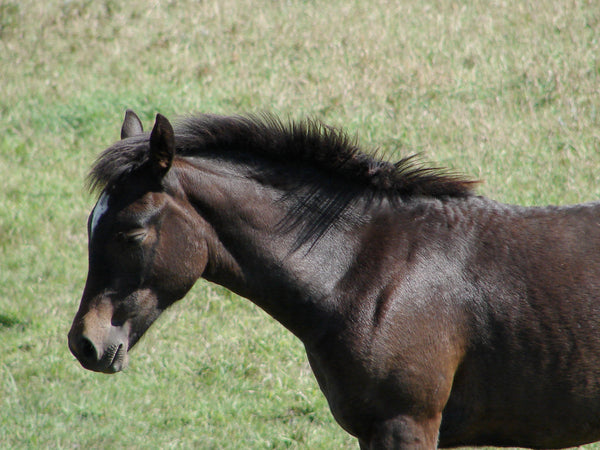There are so many ways a horse may injure its cervical vertebrae or damage the muscles and tendons of the neck, from participation in demanding sports, being ridden with ill-fitting tack, being ridden improperly, by pulling back when tied, trailering, and more.
Such injuries often present as:
- Restricted or painful neck movement
- Unusual or inappropriate head carriage
- Difficulty raising or lowering the head
- Lameness or swelling
Massage and acupressure can combine to provide your horse with an effective and efficient means of resolving pain, relieving lameness, and restoring a balanced flow of chi throughout the body, allowing for the animal to restore his health and well-being.
After you have had your horse attended to by your holistic veterinarian and they have indicated that the injury is of a musculoskeletal or bone bruise nature, you may want to use the methods described below to assist your horse in its healing.
With acupressure we’ll want to use distal (away from the injury site), and adjacent (near the injury site) acupoints first. By doing so we reduce the possibility of aggravating the injury or increasing anxiety in the horse.
Distal Acupoints for Cervical Issues
Lu 7 is the Master for the head and neck, and its benefits include relieving cervical stiffness and neck pain. It is located on the medial aspect of the foreleg, at the level of the lower border of the chestnut, making it an excellent distal point for neck issues.
SI 3 is known to relax sinews and alleviate pain, and it benefits stiffness and neck pain. It is located in a depression at the distal end of the lateral spent bone on the caudolateral border of the cannon bone.
Adjacent Acupoints for Cervical Issues
GB 21 facilities chi flow, bringing nutrients and blood to the injured area, and it benefits shoulder and neck pain. It is located at the midpoint of the cranial edge of the scapula.
GV 14 benefits cervical pain and strengthens the immune system. It is located on the dorsal midline in a depression between the 7th cervical and 1st thoracic vertebrae, cranial to the highest point of the withers.
Use these local points as your horse allows. Be aware of and sensitive to your horse’s comfort level, move into the point very gently, or work off-body until your horse invites you to move closer.
Local Acupoints for Cervical Issues
Bl 10 dispels Wind and Cold and benefits neck stiffness. Located 2 cun off the dorsal midline in a depression caudal to the wings of the atlas.
GB 20 relieves internal wind and benefits cervical stiffness. Located in the large depression caudal to the occipital condyle.
See the chart below to locate these acupoints.

Acupressure Point Work Techniques
Begin Point Work using the direct-thumb technique. Place the ball of your thumb on the acupoint at a 45 to 90-degree angle to your horse’s body. Or, anchor your middle finger on top of your pointer finger and apply gentle pressure. When you feel resistance, let up on the point slightly and then lightly apply pressure again.
Keep both hands on the horse. One hand does the Point Work while the other feels the reactions such as muscle twitches, yawning, shaking, stretching, and other energy releases. The hand not performing Point Work rests comfortably on the horse.
Breathe out while moving into the acupoint; breathe in when letting up on the point. Stay on the point for a slow count to 20. If the horse seems uncomfortable with a particular acupoint, move on and try it again at the next session.
Massage Techniques for Equine Cervical Issues
Gently warm muscles first by placing the entire palmar aspect of your hand on the side of the horse’s neck starting at the poll and then stroking down to the withers. Come up in the opposite direction and back down again. After a few of these effleurage strokes, grip the top of the dorsal midline of the horse (nuchal ligament) and gently pull up while jostling the tissue back and forth. You may do this with one hand or two hands. As you work with the tissue, you will notice more movement in it. Next, move to the ventral side of the horse’s neck and gently take hold of the brachiocephalicus muscle, a large developed muscle responsible for drawing the neck down. Hold the tissue for a few seconds and then begin gentle jostling.

